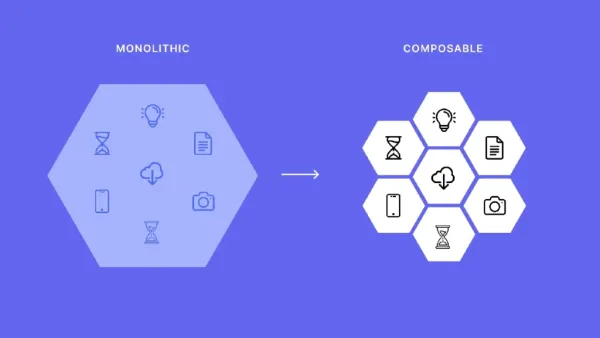
Composable Architecture is becoming essential in the world of a hyper-connected digital economy, where businesses that operate across the world have faced various challenges and opportunities that change with time. Expectations of the customers have also evolved, and competitiveness is also ever-changing with the rapid technological advancements and the changing market dynamics. For relevancy, companies must deliver seamless digital experiences, scale operations, and adapt to innovations with agility. These monolithic architectures are incapable of meeting these demands, making them more of a liability in the new environment. Composable architecture offers a flexible, modular approach, enabling businesses to meet these challenges effectively and stay competitive.

Monolithic architectures were the norm for many decades, where all the business components, such as UI, business logic, and data access layers, are interwoven and deployed as one single unit. This was simple for development, but it presented numerous long-term challenges, like a lack of swift changes, where any change in the system would require loading the entire unit. Failing to change one unit in the system would also crash the whole application. Teams will also have to coordinate their changes across the entire stack.
Composable architecture is a modern and strategic approach that breaks down applications into independent and reusable assets and allows organisations to build systems like digital building blocks, which will also help elevate the digital experience. This will also enable businesses to shift from the rigid monolith system to a more agile one, making it possible to innovate and adapt quickly and intelligently. This shift will also be a strategic business transformation, which is also a form of evolution from the traditional monolith systems.


Each component is self-contained, and the elements are assembled from independent, reusable components, including microservices, APIS, modular frontends and headless services. These components can be developed independently compared to monolith structures, and the cataloguing of the system also helps in the easier discovery of the components.
Composable models will help the business teams to move faster, as the developers can instantly update, change and swap new functions without affecting the system as a whole. This makes the team ready for rapid prototype testing, frequent updates, as well as responding to market demands swiftly without affecting the app.
In addition, composable systems also help businesses scale individual components based on demand. If one product catalogue receives a lot more traffic than the checkout system, the only scalable thing here is the product catalogue, which the teams can work on without having to change the checkout system in any way. If a business also wants to replace a unit like payment processing or analytics, it can do so without impacting the rest of the system at all.


In addition, customers want a seamless experience across their various devices, such as mobile phones, desktops, social media, and more. This type of architecture enables businesses to deliver personalised content for a seamless experience. Developers also benefit from these, as they can
Companies like Nike, LEGO and Venus Fashion have embraced the composable architecture to create a personalised shopping experience for the people by incorporating headless CMS, an independent checkout service, as well as a flexible search algorithm, due to which they can react to all the seasonal demands and trends that are ongoing. Fintech companies like Stripe, Plaid and Square also provide a plug-and-play functionality that banks can adopt without rebuilding their entire tech stack.
Healthcare and pharma companies have also integrated the composable models in their systems, which allow for seamless booking of appointments without disrupting legacy record systems and improve patient experiences with minimal risk.
While the composable architecture offers significant advantages, it also comes with various risks and challenges that organisations must navigate carefully. Managing these individual services can introduce a ton of complexity, requiring advanced analytics and governance tools. Operational costs may also rise due to the need for microservice tools and third-party integrations. Despite these challenges, however, a well-designed composable architecture will strike the balance between a flexible and well-balanced system with easy-to-work fragmentation.


The transition from monolithic systems to composable architectures will mark a fundamental shift towards how businesses approach technology and innovation. In this digital landscape that demands speed, flexibility and customer-centric architecture, we will also build a very resilient and dynamic digital ecosystem. By treating the applications as modular, interchangeable components, companies will gain the ability to innovate rapidly and respond to these changes.
While the journey toward composability involves overcoming technical complexities and operational challenges, the long-term benefits far outweigh the initial hurdles. As demonstrated by leading companies across retail, fintech, and healthcare, embracing composable architecture is not just a matter of modernising IT infrastructure but a strategic enabler of business agility and sustainable growth. In an increasingly unpredictable and competitive world, composable systems offer the adaptability and resilience that businesses need to thrive today and in the future.